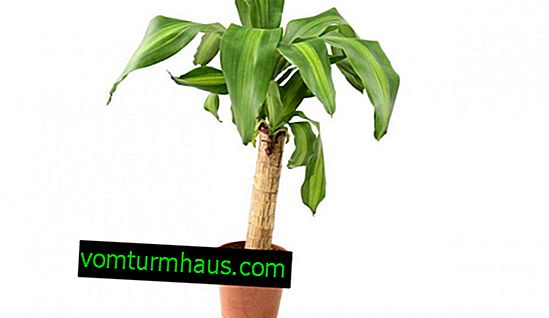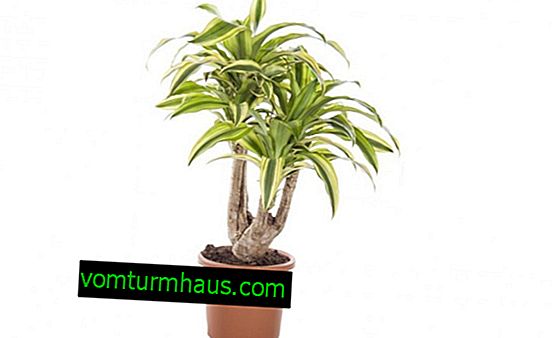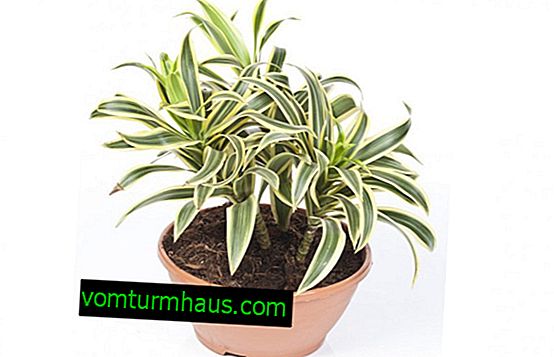Fragrant Dracaena: description, benefits and harms for the home, cultivation and care at home
Dracaena belong to the Asparagus family and look like small trees or succulent shrubs. Today, according to various sources, up to 150 species are known. Despite the fact that in the natural environment a significant part of them grows in Africa, as a houseplant, dracaena can be found almost anywhere in the world. One of the most popular types is fragrant dracaena, which will be discussed in our article.
Description of dracaena
Fragrant dracaena, or the tree of happiness, is an evergreen ornamental plant that can become an adornment of any interior. In nature, it can grow up to 6 meters, indoors, its maximum growth is up to 2 meters.

The most popular types of fragrant dracaena are as follows:
- Fragrance Massangeana;

- Fragrance Compact;

- Fragrance Lindeny;

- Mix

The benefits and harm to the home
- Dracaena is endowed with the following useful qualities:
- neutralizes the effects of chemicals;
- facilitates sensations with temperature changes;
- helps cleanse the body of toxins;
- removes pain in muscles and bones;
- promotes wound healing;
- keeps teeth in good condition;
- helps restore peace of mind;
- promotes resistance to emotional states.
- The only problem is juice, which is low toxic and if ingested, can lead to similar problems:
- digestive upset;
- diarrhea;
- shiver;
- weakness.
This is especially dangerous for babies and pets who can accidentally eat leaves.

The basic rules of growing
Despite the unpretentious care, the flower still needs to create comfortable conditions:
- there should be a maximum amount of sun, but at the same time direct sunlight should be avoided;
- in summer, it is better to take the flower outside, the main thing at the same time is to protect it from drafts;
- it is recommended to moisten the plant periodically from the spray gun;
- the pot should be several centimeters longer than the roots, but not too wide;
- the pot is better to take ceramic or plastic.
Features of home care
A plant with a graceful appearance will add brightness to any interior. However, in order to enjoy its beauty, you need to know how to properly care for a flower and what features it has.

Optimal conditions
In order for the dracaena to be beautiful and healthy, it is important to know what conditions it needs for this:
- Temperature The optimal indicator is + 19–25 ° С. In winter, the indicator should not fall below + 14 ° C.
- Humidity Dracaena can carry dry air for a short time. The best indicator of humidity is 60%, otherwise the plant requires constant spraying from the spray gun. Such manipulations, in addition to increasing the level of moisture in the air, will wash off the dust from the leaves.
- Lighting Dracaena, regardless of species, needs the maximum amount of sun, but without direct rays. In the warm season, it is recommended to take out pots on the street.
- The soil . Properly selected soil is an important condition for plant growth. If you can’t buy a finished composition, you can do it yourself. The main thing is that it contains special nutrients. For this purpose, the following components are taken in equal amounts - turf land, compost, peat and sand. Broken bricks are used as drainage.
Also find out what to do if dracaena leaves dry.
Watering and fertilizer
Moisturizing the soil should be neat, the flower is forbidden to fill. Between watering, the earth should dry by about 3 cm. For better aeration, it is recommended to loosen the soil. In hot weather, watering is carried out more often. In winter, it is recommended to spray the leaves from the spray bottle additionally.

When a salt crust forms on top, it is removed and fresh substrate added.
You need to feed the plant throughout the year. From spring to autumn they do this every 2 weeks, and the rest of the time they reduce the number of procedures to 1 time per month. For fertilizer, complex compounds are used that are specially designed for palm trees and dracaena.
Pruning
Over time, dracaena extends upward, while the lower leaves dry and fall. As a result, the plant more and more resembles a palm tree. To prevent the flower from losing its decorative effect, pruning is done from time to time.

To do this, remove the top of the dracaena, stepping from the end to 7 leaves. The trimmed trunk is placed in a bag and left warm. After about a month, the lateral kidneys awaken, which leads to the formation of lateral shoots. The result is a shortened, but more lush plant.
The top is not thrown away, but used for reproduction.
Transfer
The first transplant of young dracaena is carried out after 2 years. This must be done by way of transshipment. In the next and other years, the period increases to 3 years. The soil for this can be purchased, but add to it a small amount of sand, charcoal and fine brick chips. It is better to carry out such manipulations in the spring.
Important! So that the plant does not experience stress after transplantation, it is recommended to choose a new pot, the size of which is slightly larger than the previous one.
Drainage is placed in the pot, sand is placed on top, then the plant is transplanted in the center, adding earth to fill the entire tank. The earth is slightly compacted and watered. The container with the plant is left warm, fertilizer is applied only after the appearance of a new central leaf.
Video: Transplantation and features of caring for Dracaena fragrant
When and how does fragrant dracaena bloom?
A distinctive feature of Fragrance dracaena is the aroma that flowers exude. On this plant, flowers appear more often than on other species, outwardly resemble the flowering of a chestnut, while they are painted in white or light green. Blooming buds on peduncles up to 90 cm long, which are located in the centers of outlets.
Did you know? In South America, ropes are made from large leaves of dracaena.
Breeding
It is recommended to carry out such manipulations in the spring.
Seeds
It is important to know that this method of propagation is only suitable for dracaena with completely green leaves.
To obtain new plants, you need to carry out the following manipulations:
- Seeds before planting are soaked for 24 hours in a solution to stimulate germination.
- The temperature at this time should be at + 30 ° C.
- Then the seeds are planted in the ground, while the container is covered with a film or a lid.
- The first sprouts will begin to appear after 1.5 months.
- During this time, it is recommended to carry out at least one top dressing and carry out systematic watering.
- After reaching a height of 5 cm, seedlings are transplanted into a pot without fail.

Apical cuttings
This method is suitable for dracaena, which imitate palm trees with a common trunk and several branches on top. Most often, apical cuttings are removed when they interfere with each other's growth.
Reproduction is carried out as follows:
- The tip is cut with a sharp blade up to a length of 15 cm.
- The top is placed in a container of water in which a tablet of activated carbon is previously dissolved. It is important that the sun does not fall on the stalk.
- From above the container is covered with polyethylene to create a greenhouse effect.
- Regularly irrigate with warm water.
Video: Dracaena propagation by apical cuttings
Stem cuttings
Reproduction in a similar way is carried out as follows:
- A 6 cm long stem is cut, it is important that it has at least 2 buds.
- The tank is filled with soil and a stem is placed in it.
- A layer of sand is poured on top.
- The design is covered with a jar or a bottle and put away in a dark warm place.
- Every few days the soil is watered.
Video: Dracaena propagation by stem cuttings
Diseases and Pests
Dracaena is quite resistant to diseases and pests, but, despite good immunity, it can be affected by the following pests:
- aphid;
- spider mite;
- mealybug;
- trips;
- thyroid gland.
Also, dracaena can get sick:
- light brown spotting;
- alternariosis;
- phylostictosis.

The lack of sunlight is the cause of the appearance of spots on the leaves, as well as changes in their color or dryness. Getting rid of the problem is simple - just move the pot to another place.
Fragrant dracaena is an easy-to-care plant with many useful properties. Follow these recommendations, and there will be no problems with its cultivation.







